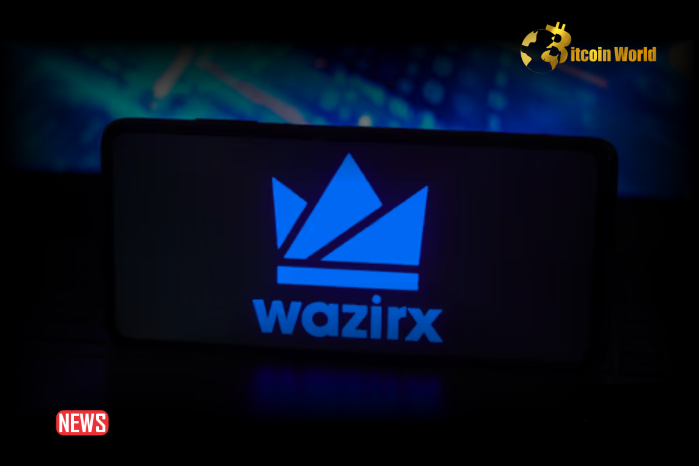Cryptocurrency users on Indian exchange WazirX are navigating choppy waters. Following a massive $230 million cyberattack, the platform is implementing a controversial ‘socialized loss strategy’. What does this mean for you if you’re a WazirX user? In essence, to get the platform back online swiftly, the impact of the hefty loss is being distributed across all users. Let’s dive into the details of this unprecedented situation and what it means for your crypto holdings.
WazirX’s ‘Socialized Loss’: A 55/45 Split
WazirX announced that only 55% of user crypto assets will be immediately accessible. The remaining 45%? It’s being converted into USDT-equivalent tokens and, for now, locked. This move, described by WazirX co-founder Nischal Shetty as the “fastest way to open the platform again for operations,” has understandably sparked a lot of discussion and questions within the crypto community.
Decoding the Cyberattack and the Socialized Loss Strategy
Last Saturday, WazirX updated users about the aftermath of a significant cyberattack. The damage? A staggering $230 million, equating to roughly 45% of all user funds held on the exchange. To address this, WazirX is taking a unique approach – a ‘socialized loss strategy’. But what exactly does this entail?
According to WazirX’s official statement, this strategy is designed to be:
- Fair: Distributing the financial blow across all users rather than a select few.
- Transparent: Openly communicating the process and rationale to its user base.
- Fast: Aiming for a quicker platform recovery and resumption of services.
The core of this strategy is the 55/45 split. Here’s a breakdown:
- 55% of your crypto assets: Immediately accessible for trading and withdrawals (depending on your chosen option).
- 45% of your crypto assets: Converted to USDT-equivalent tokens and temporarily locked.
WazirX argues that this approach is a necessary evil, offering a faster solution compared to traditional recovery methods that can drag on for years, leaving users in limbo with limited access to their funds.
Why ‘Socialized Loss’? Is it Really the Fastest Way?
Nischal Shetty, WazirX co-founder, took to social media platform X to explain the rationale behind this decision, stating, “The fastest way to open the platform again for operations is to socialize the loss across the crypto portfolios.”
He further clarified that:
- INR balances are safe: The socialized loss strategy solely impacts crypto portfolio balances, not INR wallets.
- Partial lock only: It’s a partial lock of crypto assets, not a complete freeze.
- Phase 1 of recovery: This is just the initial step in a broader recovery plan.
Shetty emphasized that this isn’t the end of the road, but rather the beginning of “phase 2,” which will focus on comprehensive recovery efforts. These efforts will include:
- Asset Recovery: Actively working to recover the stolen funds.
- Seeking External Help: Exploring partnerships and external resources to aid recovery.
- Innovative Solutions: Considering airdrops, new token use cases, and leveraging future exchange profits to potentially compensate for the locked funds.
User Options and Key Dates: What You Need to Do
WazirX registered users should have received an email with detailed instructions and a link to select their preferred option regarding their assets. It’s crucial to note these key details:
- Asset Valuation Date: The value of unlocked assets is based on the average prices from Coinmarketcap and major global exchanges as of July 21, 2024, the day trading was halted on WazirX.
- Option Selection Deadline: Users must submit their choices by August 3rd.
- Platform Reopening: WazirX anticipates resuming platform operations shortly after the poll concludes.
Pros and Cons of the Socialized Loss Strategy
Let’s weigh the potential advantages and disadvantages of this approach:
| Pros | Cons |
|---|---|
| Faster Platform Recovery: Potentially quicker resumption of trading and withdrawal services. | Immediate Loss for Users: Users experience an immediate reduction in their accessible crypto assets. |
| Partial Access to Funds: Users regain access to 55% of their crypto holdings relatively quickly. | Uncertainty about Locked Funds: The future recovery and value of the locked 45% remain uncertain. |
| Transparent Communication (allegedly): WazirX is attempting to be transparent about the situation and its strategy. | User Dissatisfaction: Many users may feel unfairly penalized for the exchange’s security breach. |
| Potential for Future Recovery: WazirX plans further recovery efforts, offering a glimmer of hope for the locked funds. | Precedent Setting: This strategy could set a precedent for other exchanges facing similar situations, raising concerns about user fund security. |
What Does This Mean for WazirX Users and the Crypto Space?
WazirX’s ‘socialized loss strategy’ is a bold and somewhat controversial move. While it aims for a swift platform recovery and offers users partial access to their funds, it also places the burden of a significant security breach directly on the users. The long-term implications of this strategy remain to be seen.
For WazirX users, it’s crucial to:
- Check your email: Look for the official communication from WazirX regarding option selection.
- Understand the options: Carefully review the choices presented and their implications.
- Submit your choice by August 3rd: Adhere to the deadline to ensure your preferences are considered.
- Stay informed: Keep following WazirX’s official updates and announcements regarding the recovery process.
This incident serves as a stark reminder of the inherent risks in the cryptocurrency space, particularly concerning exchange security and user fund protection. It also raises important questions about the responsibilities of crypto exchanges in safeguarding user assets and the fairness of ‘socialized loss’ models in the face of cyberattacks.
What are your thoughts on WazirX’s socialized loss strategy? Do you think it’s a fair approach? Share your opinions and concerns in the comments section below.
Disclaimer: The information provided is not trading advice, Bitcoinworld.co.in holds no liability for any investments made based on the information provided on this page. We strongly recommend independent research and/or consultation with a qualified professional before making any investment decisions.



